US soldiers test new JETS-TLDS laser targeting system
Posted on
Ten Field Artillery Soldiers tested the Joint Effects Targeting System Target Laser Designation System at the Cold Regions Test Center here recently.
The JETS-TLDS is a modular advanced sensor suite of three components, the hand-held target location module, precision azimuth and vertical angle module, and laser marker module.
According to Staff Sgt. Timothy S. Phillips, a Research, Development, Test & Evaluation NCO from the U.S. Army Operational Test Command’s Fires Test Directorate, forward observer are an essential part of the modern battlefield.
“FOs have a critical role as a key element of a Fire Support Team; providing indirect fire support at the company/troop level,” said Phillips. “JETS-TLDS allows the FOs to quickly acquire and locate targets for any given fire mission.”
Additionally, the system provides 24/7 all-weather precision targeting and target-acquisition to support dismounted operations.
Phillips explained that Soldiers from Battery D, 2nd Battalion, 8th Field Artillery Regiment with military occupational specialty 13F (Fire Support Specialist), were selected for the test to gather operational data because of their experience and knowledge detecting targets for fires.
After spending several weeks training and testing, the Soldiers seemed confident in their ability to employ the JETS-TLDS system.
“I was excited about the amount of missions we processed each day with the JETS-TLDS,” said Spec. Dallas A. Mason, of Battery D. “I was proud to be able to participate in the testing of this system.”
Each test day involved 10 hours of operational use and averaged 40 target acquisitions per FO team.
The test provided the FO teams an operationally realistic approach to detect, recognize, and identify targets in a tactical environment. Soldiers were dropped off at a release point where they began a tactical foot movement over the mountainous Alaskan terrain at elevations between 1,000-2,500 meters at several different observation posts.
Upon arriving at their OP, they set up the system and established their location by using system self-location methods.
JETS-TLDS also assists in determining the category of accuracy for each target location acquired by the FO.
The current legacy system issued to FOs is the Vector 21 Laser Target Locator, Mark VII, and the Target Reconnaissance Infrared Geolocating Range Finder.
JETS-TLDS provides a designator and marking device in a system that has a total weight of approximately 20 pounds which includes a tripod, and batteries.
Several test unit Soldiers agreed that the JETS-TLDS is a hybrid of the two current systems — Vector 21 and LLDR — all in one module.
“On today’s battlefield,” said Sgt. Gregory W. Caplan, another Battery D Field Artilleryman, “it is imperative to ensure our Fire Support Teams have the newest most current digital systems available due to the continuous transformation of the battlefield.”
Operational testing of equipment systems allow senior Army leaders to have the Soldier’s opinion and recommendations to make an educated decision on full rate production, according to Lt. Col. Michael P. Frank, project manager at Soldier Sensors and Lasers (PM SSL) out of Fort Belvoir, Virginia.
“Putting this system into the hands of Soldiers in a realistic operational environment is critical to the operational testing process,” said Frank. “Senior Leaders require a Soldier’s opinion.”
At the Soldier level, Field Artillery troops understand their input is valuable to the Army.
“I was surprised that as a specialist in the Army, I would be able to provide feedback that could eventually impact the decision the Army would make concerning the future of our MOS and the JETS-TLDS,” said Spec. Israel C. Wallace of Battery D.
Besides offering readiness through training, Phillips said that testing JETS-TLDS in the environment Alaska provided was crucial to the test, to make sure it will be effective in a Soldier’s hands and suitable for the environments Soldiers train and fight in.
“Often, FOs encounter extremely rough terrain that must be crossed with the threat of enemy combatants being near,” Phillips said.
“Moving with full combat load not only stresses the system, but also provides realistic training for the FO and ensures they are able to put the system into action under realistic operational scenarios.”
SOURCE: Chief Warrant Officer 4 Robert J. Stoll, Fires Test Directorate, U.S. Army Operational Test Command Public Affairs


Subscribe to our newsletter
Promotions, new products and sales. Directly to your inbox.
